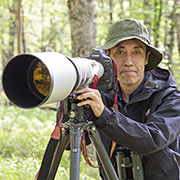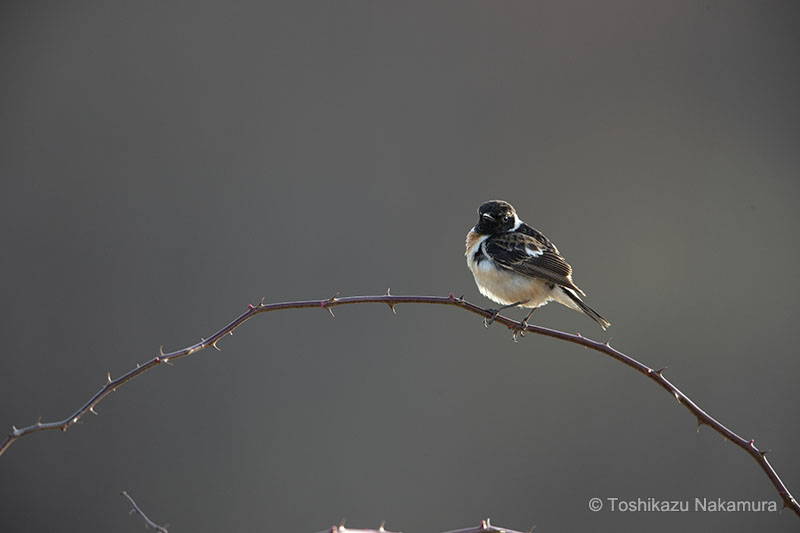Toshikazu Nakamura | BV-HEAD
Theme
Birds and wildlife
Photographer
Toshikazu Nakamura
Date
April-May 2018
Location
Nagano, Shizuoka, Chiba Prefectures
Device
Markins
Canon
EOS-1D X Mark II
EF600mm F4L IS II USM
EF100-400mm F4.5-5.6L IS II USM
EF600mm F4L IS II USM
EF100-400mm F4.5-5.6L IS II USM
Gitzo
GT4542LS
Review

Toshikazu Nakamura
Born in Kanagawa Prefecture in 1966. After graduating from Nihon University College of Art with a degree in photography, worked as an assistant before becoming a freelance photographer. Started observing wild birds in high school under the influence of a friend and has been recording their natural expressions and gestures, focusing on familiar wild birds. Particular about “light” and tries to take photographs in which “light” can be felt.
Member of Wild Bird Society of Japan
Member of the Society of Scientific Photography of Japan (SSP)
- Photo Collection/Book -
2017
"BIRD CALL" (Seijinsha)
2018
"Capturing the decisive moment of a living creature" (Bunichi Sogo Shuppan, co-author)
- Photo Exhibitions -
2018
"BIRD CALL" again LUMIX CLUB PicMate PHOTO GALLERY
The Beginning of Bird Photography
It has been more than 30 years since I started taking pictures of wild birds. Soon after entering high school, I met a friend who was taking pictures of wild birds, and we started going out together on our moped bikes to various places in search of birds.
I had always been interested in nature and had been photographing insects in junior high school and high school, but this encounter got me hooked on wild birds in a flash.
At the time, there was no way I could afford an expensive telephoto lens, so I used a 500mm mirror lens made by a lens manufacturer, but when I entered university, I acquired a 500mm telephoto lens and began taking photos in earnest.
I had always been interested in nature and had been photographing insects in junior high school and high school, but this encounter got me hooked on wild birds in a flash.
At the time, there was no way I could afford an expensive telephoto lens, so I used a 500mm mirror lens made by a lens manufacturer, but when I entered university, I acquired a 500mm telephoto lens and began taking photos in earnest.
Reduces equipment weight and prevents blurring
I use a 600mm telephoto lens and often shoot in the early morning when the light is not yet sufficient or in backlit situations, so a tripod is indispensable. In addition, I often shoot in a blind (a simple tent for photographing) and wait patiently so as not to put pressure on the birds as much as possible. The weight of the equipment for photographing wild birds becomes quite heavy when moving to the shooting location or walking around looking for birds. I wanted to make my equipment as light as possible, but it would be a real disadvantage if I took too many blurred pictures because I made it lighter. After doing some research and talking to some photographers I know who use such lenses, I became interested in the Merkins BV-HEAD set and ring plate.
I decided to try this set with the hope that it would reduce the weight of my equipment and also prevent blurring.

Until now, I have been using a Gitzo Type 5 carbon tripod with a video head for bird photography, but with the introduction of the BV-HEAD set, I switched to a Type 4 tripod. This reduced the weight of both the head and the tripod, for a total weight reduction of more than 2 kg. When I actually carried the tripod with the equipment attached, the difference of 2 kg was huge, and the burden on my shoulders when carrying it around was completely different.
There is no doubt about the weight reduction, as the figure is 2 kg, but the important thing is how easy it is to use. I have never used a free-form head before, and this set, with the BV-HEAD attached to the free-form head, which restricts the movement of the ball up, down, left, and right, is very small in size as well as in weight.
At first, I was a little concerned about the small size of the head since the 600mm lens and the EOS-1D X Mark II are quite a large combination, but my fears were quickly dispelled when I actually used the head for shooting. The lens stops exactly where you want it to by tightening the fixing knob, whether up, down, left, or right, making it easy to frame the shot exactly as you want it. By adjusting the tightness of the ball fixing knob, you can get the friction you prefer, and the movement is smooth and very easy to use. The head moves smoothly and stops immediately, allowing for quick framing.
There is no doubt about the weight reduction, as the figure is 2 kg, but the important thing is how easy it is to use. I have never used a free-form head before, and this set, with the BV-HEAD attached to the free-form head, which restricts the movement of the ball up, down, left, and right, is very small in size as well as in weight.
At first, I was a little concerned about the small size of the head since the 600mm lens and the EOS-1D X Mark II are quite a large combination, but my fears were quickly dispelled when I actually used the head for shooting. The lens stops exactly where you want it to by tightening the fixing knob, whether up, down, left, or right, making it easy to frame the shot exactly as you want it. By adjusting the tightness of the ball fixing knob, you can get the friction you prefer, and the movement is smooth and very easy to use. The head moves smoothly and stops immediately, allowing for quick framing.
About Ring Plate

The ring plate is attached by removing the factory tripod mount. By replacing the tripod mount with the ring plate, the center of gravity is lower than that of the stock tripod mount, which is taller, and the ring plate is supported at two points, which greatly improves vibration suppression. When the ring plate is actually attached to the lens and set on a tripod, the advantages of the solid construction and two-point support can be felt. In the past, even when the lens was set on a tripod and all movable parts were securely tightened, the lens would move slightly when the camera was held or operated, but after switching to the ring plate, this slight movement was virtually eliminated. The long rail makes it easy to adjust the center of gravity even if the weight balance of the lens and body changes when the camera body is changed.
When the lens is changed to a ring plate, the front of the lens is held in place by a ring, so it is a single action plus when the lens is rotated or the framing is changed vertically or horizontally. This is because both the screen switching lock knob on the lens and the ring fixing knob on the ring plate must be loosened. Since there is a trade-off between preventing blurring and ease of revolving, it is best to consider which of the two should be prioritized. In my case, I often wait until I have decided on the framing from the beginning to take a picture, except in situations where I need to change the vertical and horizontal settings on the spur of the moment, so I gave priority to the prevention of camera shake. A blurred picture that is not what I am aiming for is of no use to me.
After using the Marquis BV-HEAD set and ring plate for a little less than two months, I found it very easy to use and once I got used to the lightness of the head, the original video head felt incredibly heavy and I could no longer live without it.
When the lens is changed to a ring plate, the front of the lens is held in place by a ring, so it is a single action plus when the lens is rotated or the framing is changed vertically or horizontally. This is because both the screen switching lock knob on the lens and the ring fixing knob on the ring plate must be loosened. Since there is a trade-off between preventing blurring and ease of revolving, it is best to consider which of the two should be prioritized. In my case, I often wait until I have decided on the framing from the beginning to take a picture, except in situations where I need to change the vertical and horizontal settings on the spur of the moment, so I gave priority to the prevention of camera shake. A blurred picture that is not what I am aiming for is of no use to me.
After using the Marquis BV-HEAD set and ring plate for a little less than two months, I found it very easy to use and once I got used to the lightness of the head, the original video head felt incredibly heavy and I could no longer live without it.

■ Himantopus himantopus
Canon EOS-1D X Mark II / EF600mm F4L IS II USMF5.6 1/400 s -1EV ISO400

■ Troglodytes troglodytes
Canon EOS-1D X Mark II / EF600mm F4L IS II USMF4.0 1/200 s +1EV ISO800

■ Saxicola torquata
Canon EOS-1D X Mark II / EF600mm F4L IS II USMF5.6 1/640 s -2/3EV ISO800

■ Sciurus lis
Canon EOS-1D X Mark II / EF600mm F4L IS II USMF4.0 1/500 s +1 1/3EV ISO800






